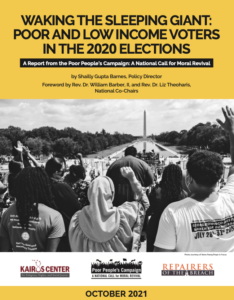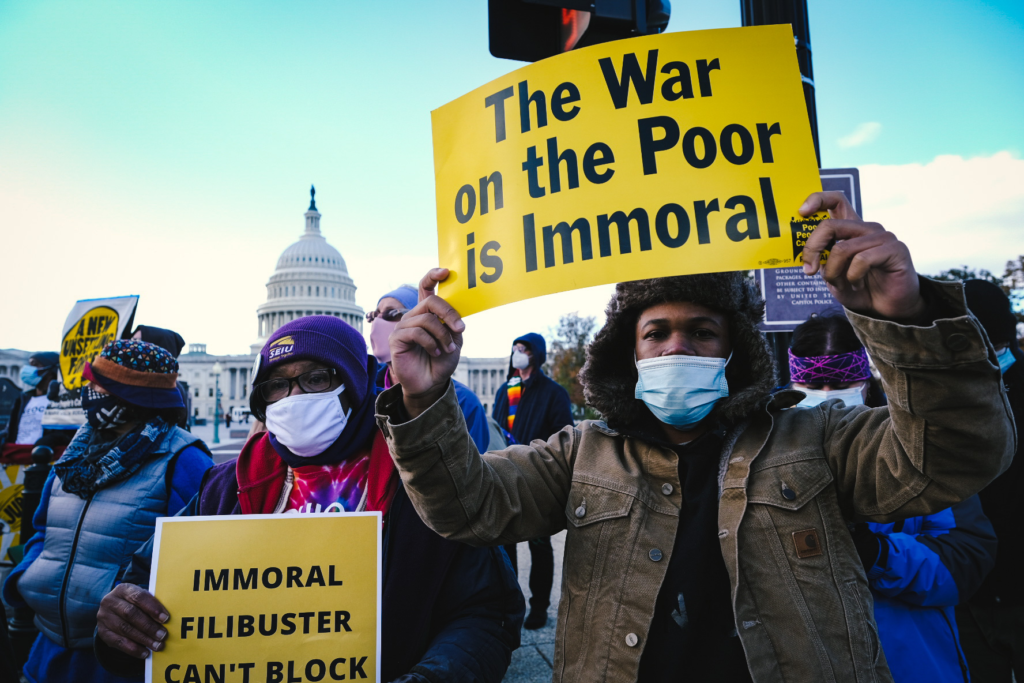
Days before Thanksgiving, I walked by a long line of people waiting to fill their carts with food set up outside a local church. Elderly women, families with small children and individuals of every race, age and ethnic group had their carts ready for boxes of corn flakes, jars of peanut butter and other goods. This is just one of hundreds of lines in New York City, and one of tens of thousands across the country, that are working to meet the food security needs of at least 38 million people – including one in six children – who don’t have enough to eat.
There is no need for this widespread insecurity. Meeting everyone’s food needs would cost just over $20 billion: this is less than half of the Pentagon’s 2022 Budget on lethal air forces like 85 F-35 bombers (made by Lockheed Martin and which may soon be ready to carry nuclear weapons) and, on a yearly basis, less than the tax cut proposed in the Build Back Better Agenda. It is less than one-tenth of one percent of our national GDP. Yet, as a nation, we are far more likely to fund war and cut taxes for the wealthy than we are to address hunger, homelessness or access to water or health care. Whereas we can expect the bloated military budget to pass within days, the Build Back Better Act (BBBA) has been stalled in Congress for months.
There is no need for this widespread insecurity. Meeting everyone’s food needs would cost just over $20 billion: this is less than half of the Pentagon’s 2022 Budget on lethal air forces.
This month’s policy briefing is focused on the BBBA and building the political will to pass the most ambitious anti-poverty agenda in decades. While the Democratic party is trying to build popular support for this agenda now, the political momentum they need is flagging. The most optimistic outcome is that the BBBA passes the Senate in December, but this is not reassuring to the millions of people who are facing higher prices for basic needs. Indeed, pandemic unemployment insurance and eviction moratoriums have expired, stimulus checks have been spent and inflation is stretching household spending beyond reasonable expectations.
As Marcela Ramirez, an undocumented produce worker, says below, now is the time for “deeds, not words.”
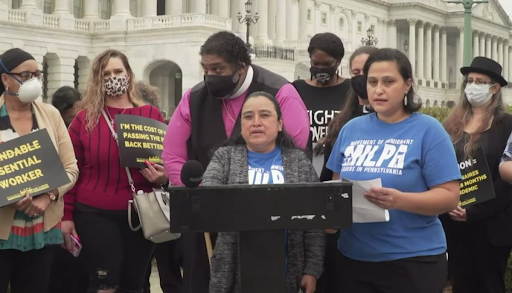
The BBBA is a part of the Build Back Better agenda, President Biden’s vision of how to “make ending poverty a theory of change.” After the American Rescue Plan Act (ARPA) was enacted in March, the two major pieces of legislation around this agenda have been the Infrastructure Investment and Jobs Act (IIJA) and BBBA. While the IIJA addresses the physical infrastructure of the country (roads, bridges, water systems, ports, green energy, etc.), the BBBA addresses our human infrastructure through programs that would secure some basic human needs that are going unmet for millions of people.
Throughout these negotiations, the Congressional Progressive Caucus has asserted itself as an emerging political force in Congress. Under the leadership of Rep. Pramila Jayapal, the CPC insisted for months that the infrastructure bill and BBBA move together through Congress, both to keep their priorities on the political agenda and to maintain broad support for both bills, for as long as possible. “We’re not used to being on the winning side of things,” said Rep. Jayapal in an interview with Anand Giridharadas earlier this year. “Governing when our voices are actually being taken into consideration is kind of a new experience.”
What else could I be thinking about, creating, doing, if I didn’t have to waste so much energy thinking about having enough money to simply survive?
kris olsen
As we have written before, the BBBA is too small to address the breadth of what is necessary, but it is a step towards securing some life-saving resources right now. Programs like the Child Tax Credit, expansions of the Earned Income Tax Credit, paid leave and Medicaid expansion will significantly improve the lives of millions of people. Kris Olsen, a single mother from West Virginia and leader in the West Virginia Poor People’s Campaign, has spoken to the benefits her family has experienced from the CTC:
“It was such a relief when I received my first $300 payment….It has allowed me to meet my son’s most basic needs with a little less stress…it has allowed me to be a better mother because instead of worrying so much about the bills, I can focus on my son! For these past two months in particular, while my son’s father has been between jobs and unable to pay child support, the Child Tax Credit allowed me to breathe a little easier. Without it I would have had to borrow money. It makes me think: what else could I be thinking about, creating, doing, if I didn’t have to waste so much energy thinking about having enough money to simply survive.”
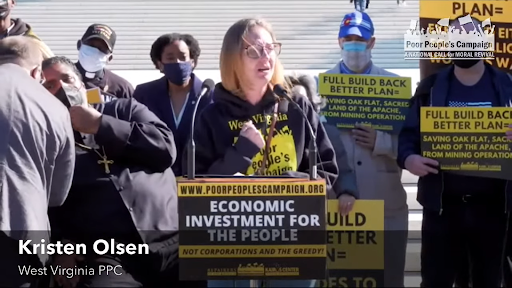
Changing the Narrative, Changing the Narrator
Due to the slim Democratic majority in the Senate, the legislative process being used to advance these bills is budget reconciliation, which requires a simple majority or just 51 votes to pass, rather than the 60 votes needed to bypass the filibuster. If all Democratic members vote together, then Vice President Harris can break the 50-50 tie and pass a reconciliation bill. However, reconciliation bills are also subject to the Byrd rule, which brings some provisions that may not have a budgetary impact under scrutiny and potential removal.
These two idiosyncrasies of reconciliation have allowed for complicated political dynamics. On the one hand, the 50-vote threshold allows for one or two Democratic Senators to withhold their support until their demands are met. Indeed, Senators Manchin and Sinema are more or less responsible for cutting the BBBA down more than $1 trillion. On the other hand, the Senate Parliamentarian has suggested that immigration reform and living wages do not have a budgetary impact. And, despite the onslaught of voter suppression laws being introduced and enacted in dozens of states, voting rights were never part of the conversation. After months of negotiations, the BBBA finally passed in the House and is now in the Senate, where it is not likely to come to a vote until mid-December.
For those of us who have been monitoring these negotiations, this has been a long and difficult period. While lawmakers’ every move have dominated media attention, we have not heard enough from the millions of people who are out of work or working in unsafe conditions, who lost pandemic unemployment benefits, who are waiting in line for cornflakes and peanut butter and who have to decide between getting their medications or paying their water bill. Some of these daily struggles may have been alleviated by the CTC and EITC, but without living wages, debt relief, or health care that relief will only last a few days at a time.
This is why the Poor People’s Campaign has been calling on President Biden to meet with poor and low-income people who are facing these impossible decisions. He should hear from Jordan Scott, a young graduate student in Florida with diabetes. He spends 9-10% of his $22,000 salary on medical bills. There have been times in his life when he had to ration test strips and couldn’t afford insulin. As he said on October 15, 2021, “Let me tell you, it is not easy to ask for insulin and, on the other end, it isn’t easy to give insulin.” He’s worked in warehouses for 70-80 hours a week and in childcare. Although his wages would not be any better with the BBBA, his medication might be more within reach: the BBBA caps out-of-pocket costs for insulin at $35 per month for Medicare recipients and capped at the price of inflation for private insurers.
This is why the Poor People’s Campaign has been calling on President Biden to meet with poor and low-income people who are facing these impossible decisions.
He should hear from Marcela Ramirez, an essential worker and undocumented immigrant leader in Pennsylvania. She works more than eight hours a day packing apples and other produce for children’s snacks in our schools. She has said, “We are the ones who could not rest during the pandemic. We are the ones who don’t have the right to get sick, because we cannot miss work, those who run the risk of getting fired if we miss a day of work…. I imagine a world where I don’t have to kill myself working so hard to pay my bills, a world where I spend more time with my daughter and less time at work. Such a world is possible. If you don’t believe me, ask the millionaires who enjoy this privilege. Enough with promises. We need deeds, not words.”
He should hear from Linell Stokes-Fall, a teacher from Maryland. She lost her job and her health care during the pandemic, because she didn’t have paid leave. Her treatment for long-COVID burns her whole body, because her health care won’t cover the less invasive treatment.

He should hear from Joan Steede, a homecare worker with SEIU from Arizona, who started caregiving in a trailer fifty years ago when she was 15 ½ years old. She has been taking care of a woman with stage four pancreatic cancer, working from 8pm to 8am, then driving to another job from 9-1pm. As she said on October 12, 2021, “There are people in this country who are dying in their bed right now from cancer. Members of Congress are going on vacation and leaving them in their beds to die. I have veterans who can only afford to pay me two hours a day, but I stay for five hours because they deserve the care they need….Home health care is our future, not just because of COVID, not just because of cancer, but because we will all someday get old and need care. I demand members of Congress do your job – build back America.”
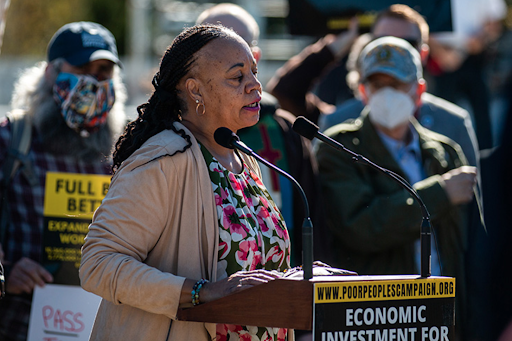
Their stories might have summoned more political urgency around enacting the Build Back Better agenda. Maybe they would have compelled the political will to pass a bolder, bigger and better BBBA, not out of pity, but because their experiences reflect the conditions facing at least 140 million people who need this administration to take bolder, bigger and better action.
Instead, the prevailing story of “Build Back Better” is about “Manchinema,” two reckless lawmakers whose hearts and minds must be won over to the BBBA. Maybe the story is also about the filibuster and Senate Schumer finding a way around the 60-vote threshold. Consequently, too many people don’t know enough of what’s in the BBBA, or maybe they don’t care because the story we hear is too far removed from their lives. Either way, these narratives aren’t nearly as compelling as hearing from Kris, Jordan, Marcela, Linell, Joan, or millions of others in similar crises.
Waking the Sleeping Giant
This is not to say that poor and low-income people, i.e., the people who might be most impacted by the policies and programs in the BBBA, are uninterested in politics. According to a new report from the Poor People’s Campaign titled, Waking the Sleeping Giant: Poor and Low-Income Voters in the 2020 Elections, one-third of the votes cast in the presidential election came from poor and low-income people. This wasn’t limited to one region or part of the country; rather, in 45 states, these voters accounted for at least 20% of the votes. In battleground states, their numbers went up to over 30-40% of the total votes cast.
As is detailed in the report, these voters were diverse across race. In fact, in the battleground states, poor and low-income white voters accounted for a higher share of votes than all other racial categories of poor and low-income voters combined. This presents a challenge to the narrative that took hold after the 2016 election about poor white voters voting not only against their own interests, but also the interests of poor people of color. Notwithstanding the unique circumstances of the 2020 elections, these numbers suggest that poor and low-income voters can and will vote together, across race, around a common agenda. In the words of Nicole Hill, who was displaced by Hurricane Katrina to Detroit: “Poverty is a decision that others made for us, but our votes can change that.”
We know this won’t happen on its own, but we also know what it might take to get there. Leading up to the election, the Poor People’s Campaign reached out to nearly 2 million poor and low-income voters in 16 states, including key battleground states like Arizona, Georgia, Pennsylvania and Wisconsin. It was the only voter drive that we know of that was non-partisan, bilingual (in English and Spanish) and in ASL. It was executed by trained volunteers from across the country. The numbers show that our work had a positive and statistically significant impact on the targeted population. Meaning, the Campaign’s voter outreach drive contributed to higher turnout rates among poor and low-income voters – white, Black and Hispanic – than similarly situated voters in those states. In Georgia, the Campaign contacted more than three times as many new voters as the margin of victory – over 39,000 voters as compared to the 12,000 votes it took to win in that state.
Although we cannot say that the Campaign’s outreach was the decisive factor in those 39,000 votes, it is clear that this segment of voters can have a real impact on election outcomes. It shows that deliberately reaching out to and engaging these voters, and inviting them to vote on their interests, can significantly contribute to higher turnout.
“If we don’t do this, the issue is not whether or not the Republican Party will survive or the Democratic Party will survive, but whether America will survive.”
Rev. dr. barber
Recent months have shown us, however, that what happens after these votes are cast and counted is a different story. Even though poor and low-income voters turned out in record numbers, the BBBA remains in political limbo and the broader Build Back Better agenda has been whittled down to a fraction of what is necessary. In fact, the second most expensive provision of the BBBA are tax cuts that will benefit the wealthy. This does not inspire confidence in our elected officials or the political process; however, it may also help explain Virginia’s election outcome on November 2, when Democratic candidate Terry McAuliffe lost the gubernatorial race to Republican Glenn Youngkin. Biden won Virginia by a comfortable margin in 2020 and the recent election saw higher voter turnout for both candidates.
Some have interpreted this outcome to ask whether increased voter turnout benefits the Democratic party. Given the voter suppression that has been unleashed at the state level and remains uncurbed by federal legislation, this line of questioning is not only irresponsible, but could be harmful to our democracy. It also absolves the Democratic party of any accountability to the electorate, including the tens of millions of poor and low-income voters from 2020, and the responsibility of elected officials to actually govern. As Penda Hair, a leading civil rights attorney with Forward Justice, said at a press conference on the low-income voter report: “The majority of the people in this country are moral people who favor a moral policy agenda…I’ve been hearing the word ‘apathy’ for the entire 40 years that I’ve been doing this work, saying that poor people are ‘apathetic’ about elections…This is not about apathy. As this report documents, [lower voting rates are explained by] a lack of discussion of issues and interests of poor people in political dialogue, a lack of candidates who run on a moral agenda, and a lack of candidates who stick to that moral agenda once they get elected and fight for it, with all the strength they have.”
This is the lesson that must be carried forward into 2022 and beyond, not to save any political party or any particular agenda, but for the nation we have yet to be, where a thriving democracy ensures that our potential is fully realized and all of our needs are fully met. Or, as Rev. Barber stated for an article in Yes! magazine, “If we don’t do this, the issue is not whether or not the Republican Party will survive or the Democratic Party will survive, but whether America will survive.”
